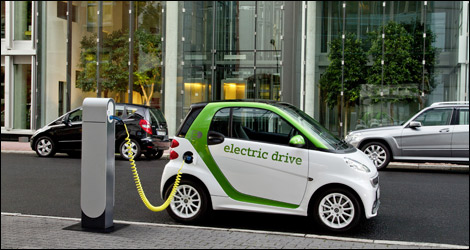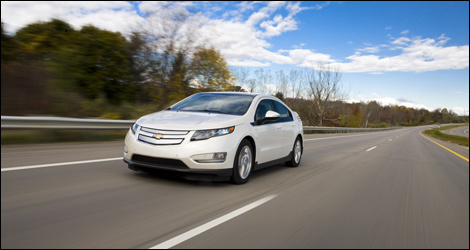Jun
5th
Stay connected Subscribe to our RSS feed
Since 2012 green vehicles have been the talk of the town from Canadian government financial incentives to a new CAA web page dedicated to the implementation of charging stations at various locations throughout the country.
What are the different types of green vehicles?
There are three categories of green vehicles in the North American market. Once you've sorted out the differences you'll know which is best for you. Count the number of motors, find out which ones propel the vehicle, and you're all set.
All-electric
The EV (or electric vehicle) is equipped with a single, battery-powered motor. The electric power is delivered to the wheels through an axle. Forget the mythical in-wheel electric motor; it is not used by any of the major manufacturers.
The EV community consists of the Nissan LEAF, the Mitsubishi i-MiEV, the smart fortwo electric drive, the Ford Focus EV and the complete Tesla lineup of vehicles.
Hybrid
Hybrid vehicles -- which are the majority of green vehicles offered on the market -- are generally comprised of a combination of an internal combustion engine and one or more electric motors that work together to propel the vehicle. An onboard computer determines the most efficient use of one or more of these motors. The goal is to provide the best energy-efficient configuration. Therefore, the electric and gas engines are used in tandem to power the vehicle.
This hybrid combination is the most widely available green vehicle in the market. The Honda Civic Hybrid, the Volkswagen Jetta Hybrid, and the Ford Fusion Hybrid are among the most popular models. Certain vehicles were born as hybrids only (with no gas-only version available): the popular Toyota Prius, the Honda CR-Z, and the rare Honda Insight are examples of this approach.
Extended-range electric vehicles
An extended-range electric vehicle has both a combustion and an electric engine. It operates as a battery-only electric vehicle for a certain number of miles. After the battery has been discharged, the combustion engine kicks in to power an electric generator for several hundred miles of “extended-range” electric-powered driving. The battery can be recharged at both 120- and 240-volt outlets.
Only a few models use this system, such as the Chevrolet Volt, the Opel Ampera and the luxurious Fisker Karma. They will be joined by the Cadillac ELR by 2014.
Let's talk plug-in hybrid
The term “plug-in” applies to vehicles that can be plugged into an electrical outlet, which is used to recharge the batteries as a power source, in addition to the fuel tank. This means there is an extra battery which provides additional electric autonomy.
The Volt has electric power autonomy of 60 kilometres compared to the newer Ford Fusion Energi and Ford C-max Energi at 32, and the plug-in Toyota Prius at 25. These few kilometres let you start your day without fuel... for a while. You only need to heat the passenger compartment for the shortest time before the combustion engine kicks in. After all, why wear down the battery when there's a so-called combustion engine at hand?
What are the different types of green vehicles?
There are three categories of green vehicles in the North American market. Once you've sorted out the differences you'll know which is best for you. Count the number of motors, find out which ones propel the vehicle, and you're all set.
All-electric
The EV (or electric vehicle) is equipped with a single, battery-powered motor. The electric power is delivered to the wheels through an axle. Forget the mythical in-wheel electric motor; it is not used by any of the major manufacturers.
 |
| The smart fortwo electric (Photo: smart) |
The EV community consists of the Nissan LEAF, the Mitsubishi i-MiEV, the smart fortwo electric drive, the Ford Focus EV and the complete Tesla lineup of vehicles.
Hybrid
Hybrid vehicles -- which are the majority of green vehicles offered on the market -- are generally comprised of a combination of an internal combustion engine and one or more electric motors that work together to propel the vehicle. An onboard computer determines the most efficient use of one or more of these motors. The goal is to provide the best energy-efficient configuration. Therefore, the electric and gas engines are used in tandem to power the vehicle.
This hybrid combination is the most widely available green vehicle in the market. The Honda Civic Hybrid, the Volkswagen Jetta Hybrid, and the Ford Fusion Hybrid are among the most popular models. Certain vehicles were born as hybrids only (with no gas-only version available): the popular Toyota Prius, the Honda CR-Z, and the rare Honda Insight are examples of this approach.
Extended-range electric vehicles
An extended-range electric vehicle has both a combustion and an electric engine. It operates as a battery-only electric vehicle for a certain number of miles. After the battery has been discharged, the combustion engine kicks in to power an electric generator for several hundred miles of “extended-range” electric-powered driving. The battery can be recharged at both 120- and 240-volt outlets.
 |
| Chevrolet Volt (Photo: GM) |
Only a few models use this system, such as the Chevrolet Volt, the Opel Ampera and the luxurious Fisker Karma. They will be joined by the Cadillac ELR by 2014.
Let's talk plug-in hybrid
The term “plug-in” applies to vehicles that can be plugged into an electrical outlet, which is used to recharge the batteries as a power source, in addition to the fuel tank. This means there is an extra battery which provides additional electric autonomy.
The Volt has electric power autonomy of 60 kilometres compared to the newer Ford Fusion Energi and Ford C-max Energi at 32, and the plug-in Toyota Prius at 25. These few kilometres let you start your day without fuel... for a while. You only need to heat the passenger compartment for the shortest time before the combustion engine kicks in. After all, why wear down the battery when there's a so-called combustion engine at hand?
 The latest auto news, reviews, prices, product and vehicle releases.
The latest auto news, reviews, prices, product and vehicle releases.